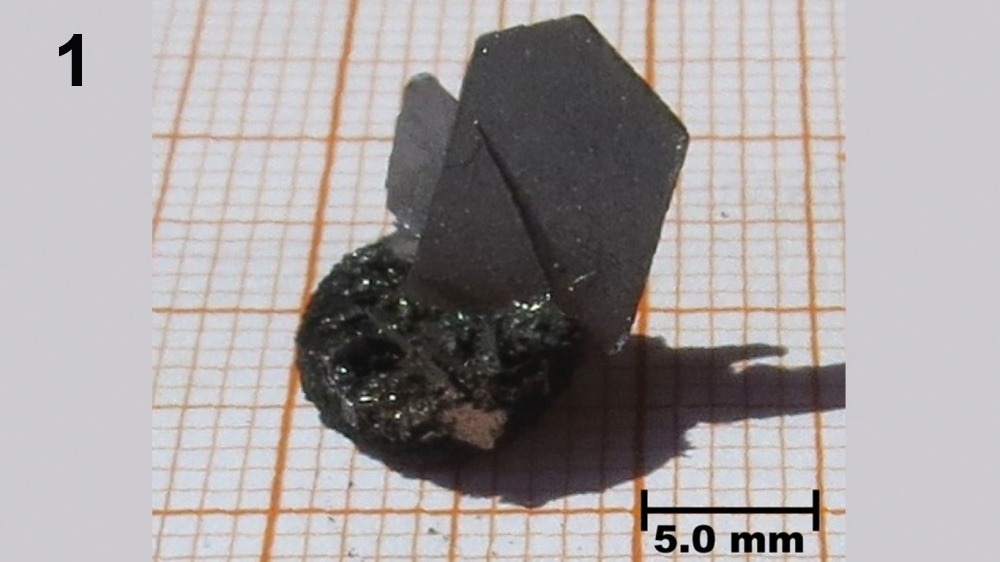Materials known as single crystals have no grain boundaries and have a continuous, uninterrupted crystal lattice that extends to the sample’s edges. In space, the atoms have definite positions that are repeated indefinitely. Monocrystals are made up of a single grain of crystal, whereas polycrystals are made up of multiple crystal grains or crystallites of various sizes and orientations.

Monocrystals of Ce0.04ZrTe2 grown by heterogeneous nucleation on the surface of the polycrystalline pellet. Image Credit: Lucas Eduardo Corrêa/USP
For the investigation of the innate physical properties of materials, a substantial supply of high-quality monocrystals is crucial. They can be created using a variety of methods. Chemical vapor transfer (CVT) is the most popular technique for producing intermetallic compound single crystals.
A team from the Lorena School of Engineering at the University of São Paulo in Brazil has developed and successfully tested an alternate method. The Journal of Crystal Growth has published an article about the subject.
Conventional CVT consists of a chemical reaction in which the compound reacts with the chemical agent to form a volatile complex. This complex moves to a different region of the experimental apparatus with a different temperature from that of the zone in which the first chemical reaction occurred and is eventually deposited in the form of a single crystal.
Lucas Eduardo Corrêa, Study First Author and Researcher, Fundação de Amparo à Pesquisa do Estado de São Paulo
Corrêa added, “A temperature gradient is required in order for the single crystal to grow as it creates the necessary thermodynamic potential. In the novel technique, which we call isothermal chemical vapor transport [ICVT], growth occurs without the need for a temperature gradient.”
Professor Antonio Jefferson da Silva Machado served as Corrêa’s PhD supervisor, and the study was funded by a FAPESP scholarship.
In the method we developed, the chemical potential gradient is what drives the growth of the single crystal. n a closed environment, a pellet of polycrystalline material and a transport agent are placed in contact at a constant temperature high enough to produce a reaction and form gaseous complexes.
Antonio Jefferson da Silva Machado, Study Last Author and Researcher, Fundação de Amparo à Pesquisa do Estado de São Paulo
“It is reasonable to consider that the transport agent initially reacts with the surface of the polycrystalline material, creating a chemical potential gradient between the interior of the grains and the interface with the gas phase. Owing to this gradient, thermodynamic equilibrium can’t be obtained between the gas and solid phases,” he further stated.
Machado added, “When the gas phase reaches saturation point—which is facilitated by the use of very small amounts of the transport agent—the chemical potential of the pellet is lower than that of the gas. At this point, inversion of the gas flux occurs, and the surface of the pellet serves as a point for single crystal nucleation.”
The researchers claim that the isothermal growing process provides a lot of benefits over traditional CVT. First, since isothermal growth maintains a consistent temperature throughout the experimental equipment, a two-zone furnace is not required.
A simple uniform furnace can often be used to encourage growth. Second, because the pellet itself serves as the nucleation point, there is no need to chemically attack the tube, which simplifies the growth process.
“It is important to note that the crystallographic quality of the crystals obtained is very high. No seeded crystals occur. In sum, the isothermal growth process is a simplified version of conventional CVT that can grow much larger crystals,” Corrêa added.
Although growth was achieved for almost two-dimensional materials such as ZrTe2, TiTe2, and HfTe2, the researchers are certain that the technique could be used on other systems with the proper thermodynamic circumstances.
Machado stated, “The relevance of the materials in question lies in the gap between the tellurium atoms, so that other atoms or molecules can be intercalated into the material. Indeed, the electronic structure of the compound ZrTe2 exhibits a non-trivial topology. We discovered that intercalation of nickel [Ni] into this gap leads to superconductor behavior with a critical temperature close to 4.0 K.”
The presence of charge density waves (CDWs) is another instability seen in the material that competes with superconductivity. These characteristics make such materials appealing for the research of the principles of solid-state physics in addition to possible applications in quantum computing.
As part of Corrêa’s PhD research, further intercalations were examined and evaluated by the researchers.
Journal Reference:
Corrêa, L. E., et al. (2022) Growth of pure and intercalated ZrTe2, TiTe2 and HfTe2 dichalcogenide single crystals by isothermal chemical vapor transport. Journal of Crystal Growth. doi:10.1016/j.jcrysgro.2022.126819